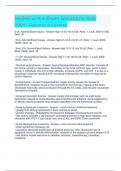2 wk. Normal Blood Values - Answer-Hgb 13-20, Hct 42-66, Retic. 1, Leuk. 5000-21000,
Neut. 40
/.3mo. Normal Blood Values - Answer-Hgb 9.5-14.5, Hct 31-41, Retic. 1, Leuk. 6000-
18000, Neut. 30
/.6mo.-6Yr Normal Blood Values - Answer-Hgb 10.5-14, Hct 33-42, Retic. 1, Leuk.
6000-15000, Neut. 45
/.7-12Yr Normal Blood Values - Answer-Hgb 11-16, Hct 34-40, Retic. 1, Leuk. 4500-
13500, Neut. 55
/.Absolute polycythemia - Answer-Type of Myeloproliferative RBC disorder. Consists of
two forms: primary or secondary. Secondary is the more common type, which is seen
mostly in individuals who live at high altitudes, smokers, COPD, and CHF. It is due to a
physiologic response resulting from increased erythropoietin secretion in response to
chronic hypoxia.
/.Acetylcholine - Answer-Parasympatheic (vagal) activity causes the release of
Acetylcholine, receptors found in the myocardium and coronary vessels of the heart.
Decreases heart rate, slows conduction through the AV nodes, and reduces myocardial
contractions strength.
/.Acquired Hemolytic Anemia - Answer-Uruslly immunologic such as erythrocyte
destruction caused by autoanitbodies against erythrocyte antigens, isohemagglutinins,
or allergic reactions against drug antigens adsorbed onto the erythrocyte surface.
/.Acute Lymphocytic Leukemia - Answer-• most common childhood leukemia
• greater than 30% lymphoblasts in bone marrow or blood
• genetic anomaly - Philadelphia chromosome (between chromosomes 9 and 22)
• risk factors: prenatal x-ray exposure, postnatal exposure to high-dose radiation, viral
infections with HTLV-1 (can cause rare form of ALL and EBV), Down syndrome
/.Acute Myelogenous Leukemia - Answer-• most common adult leukemia
• Down syndrome increases risk
• caused by abnormal proliferation of myeloid precursor cells, decreased rate of
apoptosis, arrest in cellular differentiation, mutation in the receptor tyrosine kinase FLT3
• risk factors include exposure to radiation, benzene, chemotherapy, hereditary
conditions
,/.Adult Female Normal Blood Values - Answer-Hgb 12-16, Hct 37-47, Retic.1.6, Leuk.
5000-10000, Neut. 35-70
/.Adult Male Normal Blood Values - Answer-Hgb 14-18, Hct 42-52, Retic. 1.6, Leuk.
5000-10000, Neut. 35-70
/.Agranulocytes - Answer-Contain fewer granules in their cytoplasm and the
lymphocytes do not contain any enzyme filled digestive vacuoles, and the digestive
vacuoles of the monocytes and macrophages are larger and fewer than those of the
granulocytes.
/.Albumin - Answer-Molecules are large and don't diffuse freely through the vascular
endothelium, and thus maintain the critical colloidal osmotic pressure ( or oncotic
pressure) that regulates the passage of water and solutes into the surrounding tissue
/.Albumin - Answer-Most essential role is regulation of the passage if water and dilutes
through the capillaries.
/.Alpha 1 receptors - Answer-Located in the systemic and coronary arteries, and cause
vasoconstriction when stimulated by norepinephrine
/.Alpha 2 receptors - Answer-On the sympathetic ganglia and nerve terminals are
stimulated by norepinephrine which promotes vasodilation by inhibiting norepinephrine,
and provides a safety mechanism to prevent over activity of the sympathetic nervous
system.
/.Alpha and beta thalassemia - Answer-Are inherited autosomal recessive disorders that
cause an impaired rate of synthesis of one of the two chains alpha or beta of Hb A.
/.Alpha thalassemia major - Answer-Type of Thalassemia which is a fatal condition in
which all 4 alpha-forming genes are defective; death is inevitable because a-chains are
absent and oxygen cannot be released to the tissues.
/.Alpha thalassemia minor - Answer-Type of Thalassemia in which 2 genes are
defective.
/.Alpha trait (the carrier state) - Answer-Type of Thalassemia in which a single a chain-
forming gene is defective.
/.Anemia - Answer-A reduction in the total number of erythrocytes in the circulating
blood or a decrease in the quality or quantity of hemoglobin.
/.Anemia of chronic disease (ACD) - Answer-A mild to moderate anemia resulting from
decreased erythropoiesis in individuals with conditions of chronic systemic disease or
inflammation eg. cancer, infections,chronic inflammatory and autoimmune diseases.
, /.Angiotensin-converting enzyme (ACE) inhibitors, angiotensin-receptor blockers
(ARBs), or aldosterone antagonists - Answer-Effective for those with heart failure,
chronic kidney disease, after an MI, or a recurrent stroke
Calcium channel blockers
Combination of thiazide diuretics and other antihypertensives.
/.Antithrombin III - Answer-Circulating plasma serine protease inhibitor produced by the
liver. Inhibits thrombin and several clotting factors (VIIa, IXa, Xa, XIa, XIIa). Heparin
enhances its activity, to protect the vessels from the effects of spontaneously activated
thrombin.
/.Aorta Diastole Pressure - Answer-Range 60-90
/.Aorta Systole Pressure - Answer-Range 96-140
/.Aortic stenosis - Answer-Narrowing of the aortic outflow tract (5% of defects), Caused
by malformation or fusion of the cusps, Causes an increased workload on the left
ventricle.
/.Aplastic Anemia (AA) - Answer-Critical condition characterized by pancytopenia, a
reduction or absence of all three blood cell types, resulting from failure or suppression
of bone marrow to produce adequate amount of blood cells . Usually Atuoimmune
related against hemopoeitic stem cells.
/.ASD - Answer-Abnormal communication between the atria- Allows blood to be shunted
from left to right.
/.Atrial kick (contraction of the LA) - Answer-Provides a significant increase of blood to
the LV during ventricular diastole.
/.Autoimmune hemolytic anemias (AIHAs) - Answer-Acquired d/o caused by
autoantibodies against antigens normally on the surface of erythrocytes.
/.Autonomic Nervous System - Answer--Influences the rate of impulse generation
(firing), depolarization, and repolarization of the myocardium.
-Influences the strength of atrial and ventricular contraction.
-Produces changes in the heart and circulatory system faster than metabolic or humoral
agents.
/.AVC defects - Answer-Results from nonfusion of the endocardial cushions
Abnormalities demonstrated in the atrial and ventricular septa and AV valves
Complete, partial, and transitional defects.
/.B cells - Answer-Type of lymphocyte used for humoral, antibody-driven adaptive
immunity.




